#pitohui dichrous
Text
Hooded Pitohui (Pitohui dichrous)

"THEYRE SO COOL!!!!!! they’re one of the few types of poisonous bird, with toxin in their skin + feathers !! their toxin isn’t strong enough to kill a human, but it can cause numbness, tingling, and even burning sensations if held. i just think these lil guys are neat :)"
"POISONOUS BIRD how cool is that"
The poison found in this bird's skin and feathers are a batrachotoxin, the same type that are used by poison dart frogs! It is thought these are derived from the diet, and that they both protect the Pitohui from predators and parasites.
Another cool thing about these birds is that they are cooperative breeders, with different members of a family group helping to protect a single nest and to feed the young. They're also social in other ways, leading mixed-species foraging flocks through the forest.
Sources:
Image Source: eBird ( Frédéric PELSY)
9 notes
·
View notes
Text
Creature Awaits #229
Each week I plan to feature an amazing creature, admiring God's fantastic artistry. Hopefully it’ll brighten someone’s day to see something new and interesting if they haven’t seen it before. : )
Continuing our October series.. "Cute…but Deadly" : )

(Still taken by accomplished photographer, Nik Borrow (CC BY-NC 2.0 Deed))
The Hooded Pitohui
Scientific Name: Pitohui dichrous
Region: New Guinea
Size: About 8.7"-9.1" (~22cm-23cm) from head through tail
Interesting Notes: Though appearing sweet and innocuous, if you happen to see this bird when in New Guinea, do not hold or pet it! Oddly enough, it is one of few, documented truly poisonous birds - the first discovered to contain toxins in its skin. The specific toxin is called homobatrachotoxin, one in the same family as those found in some poison frogs in the Americas. It causes burning and sharper pains when handling the birds, and much more dire consequences if one attempts to eat them.
#creatureawaits#beautiful birds#beautiful animals#poisonous bird#Hooded Pitohui#Pitohui dichrous#animals of New Guinea#birds of New Guinea
1 note
·
View note
Note
Thoughts on poisonous bird?
Oh well my friend, we made a post about this not too long ago, have a look...
Herps and Birds (and More) (Posts tagged toxic birds) (tumblr.com)

Hooded Pitohui (Pitohui dichrous), family Oriolidae, order Passeriformes, endemic to New Guinea
photograph by Knud Jønsson
211 notes
·
View notes
Text

Found some inspiration today and drew a Hooded Pitohui (Pitohui dichrous), one of the only birds in the world with poisonous feathers containing a batrachotoxin which is also found in the poisonous dart frogs. The source of the toxins comes from a diet of Melyrid beetles. It is from Papua New Guinea and in the old world Oriole family (Oriolidae).
#Ornithology#Bird#HoodedPitohui#Pitohuidichrous#Oriolidae#PapuaNewGuinea#Poisonous#PoisonousBird#Batrachotoxin
29 notes
·
View notes
Text
Weird Birds
all birds are weird cause they're reptiles but here are especially weird birds

Hooded Pitohui - Pitohui dichrous LC
poisonous bird, scientist confirmed if you touch it then touch your fingers to your mouth it makes your mouth numb, important science

American Dipper - Cinclus mexicanus LC
looks like normal bird, lies only genus of semi-aquatic song bird flies through water

Bearded Vulture/Lammergeier - Gypaetus barbatus NT
primarily eats bones, generally terrifying

Magnificent Frigatebird - Fregata magnificens LC
thinks it's a frog, speaks for itself

Resplendent Quetzal - Pharomachrus mocinno NT
actually an aztec god will sing again when land if free from Spanish rule

American Woodcock - Scolopax minor LC
actual nicknames include memebird, timberdoodle, mudbat bogsucker, night partridge and labrador twister, slowest flying bird 8km/h 5mph

Oilbird/Guácharo - Steatornis caripensis LC
birds that decided to become bats, live in colonies in caves, nocturnal, uses echolocation to navigate, eats fruit, who wore it better

Shoebill - Balaeniceps rex VU
actual dinosaur related to pelicans, carnivorous, makes terrifying clacking noises with beak

Hoatzin - Opisthocomus hoazin LC
stink bird, capable of fermentation digestion similar to ruminant mammals, chicks have two functional claws on wings
Maleo - Macrocephalon maleo CR EN

deadbeat parents bury their eggs in sand and leave, chicks digs it's way out dries off and within hours can fly
#Hooded Pitohui#American Dipper#bearded vulture#magnificent Frigatebird#resplendent Quetzal#american woodcock#oilbird#shoebill#hoatzin#maleo#birds#weird bird#weird animals#avian#aves#dinosaurs#critically endangered#endangered species#biodiversity
18 notes
·
View notes
Text
BRACKET D
Guinean Cock-Of-The-Rock (Rupicola rupicola)
Here he is. The gayest bird.
VERSUS
Hooded Pitohui (Pitohui dichrous)
These things are poisonous! Their entire bodies are loaded with toxins that they spread on themselves! Very cool!

26 notes
·
View notes
Text
A little Headcanon:
Brazil feels very proud to be the most biodiverse country in the world, so, in each meeting with other nations, he brings a random animal with him.
For example, once he picked out his beloved Spix's macaw and glared daggers towards Germany the whole time; in another occasion, he petted a jaguar pup in his lap, and in another one, a little incident with a baby anaconda got on the nerves of the other countries.
He's so fond of his birds, particularly the parrots, but when he walked up with an harpy eagle in his arm, the Europeans can't help but freaked out. The other nations held closer their own animals, while Panama and Colombia just screamed on exciting and started petting the enormous and intimidating bird. Thereafter, some nations started doing bets of what kind of animal will be the next time.
The situation scalate when he encouraged other countries to do the same, so, in the next meeting, Colombia calmly put down a little golden frog in the table. Spain just groaned and warned the others not to touch it. Someone asked why and Colombia, with a smile, answered "It's my Phyllobates terribilis, the most poisonous vertebrate in the world" and again, a lot of nations screamed in disbelief. Then, Brazil, pouting, took out his tiny frog, a pumpkin colored one (and also poisonous), and said he thought he would have the coolest frog. Other nations, such as Australia and Indonesia, also brought poisonous animals and before even the discussion started, the meeting room was full of dangerous spiders, snakes and even a bird! (courtesy of Indonesia).
No need to mention that bringing poisonous animals to global conferences was banned after that.
(Animals mentioned: Spix's macaw (Cyanopsitta spixii), Jaguar (Panthera onca), Green Anaconda (Eunectes murinus), Harpy Eagle (Harpia harpyja), Golden Poison Dart Frog (Phyllobates terribilis), Punpkin Toadlet (Brachycephalus rotenbergae) a recently discovered frog, and poisonous bird Pitohui (Pitohui dichrous))
9 notes
·
View notes
Text
bird fact #1
The hooded pitohui (Pitohui dichrous) is one of the few birds that can poison you, though not lethally. The avian contains batrachotoxin compounds in its skin and feathers. It’s believed this comes from their diet.
1 note
·
View note
Photo

#420, a hooded pitohui for @sleepy-dragons.
Requests for birds are open, updates happen on Thursdays.
[project tag] | [kofi]
[commissions]
Find me on: [twitter] | [pillowfort]
41 notes
·
View notes
Text
Pitohui

Hooded Pitohui by Berichard, CC BY-SA 2.0
Etymology: Inedible (Rubbish) Bird
First Described By: Lesson, 1831
Classification: Dinosauromorpha, Dinosauriformes, Dracohors, Dinosauria, Saurischia, Eusaurischia, Theropoda, Neotheropoda, Averostra, Tetanurae, Orionides, Avetheropoda, Coelurosauria, Tyrannoraptora, Maniraptoromorpha, Maniraptoriformes, Maniraptora, Pennaraptora, Paraves, Eumaniraptora, Averaptora, Avialae, Euavialae, Avebrevicauda, Pygostaylia, Ornithothoraces, Euornithes, Ornithuromorpha, Ornithurae, Neornithes, Neognathae, Neoaves, Inopinaves, Telluraves, Australaves, Eufalconimorphae, Psittacopasserae, Passeriformes, Eupasseres, Passeri, Euoscines, Corvides, Orioloidea, Oriolidae
Referred Species: P. kirhocephalus (Northern Variable Pitohui), P. cerviniventris (Raja Ampat Pitohui), P. uropygialis (Southern Variable Pitohui), P. dichrous (Hooded Pitohui)
Status: Extant, Least Concern
Time and Place: Since 10,000 years ago, in the Holocene of the Quaternary

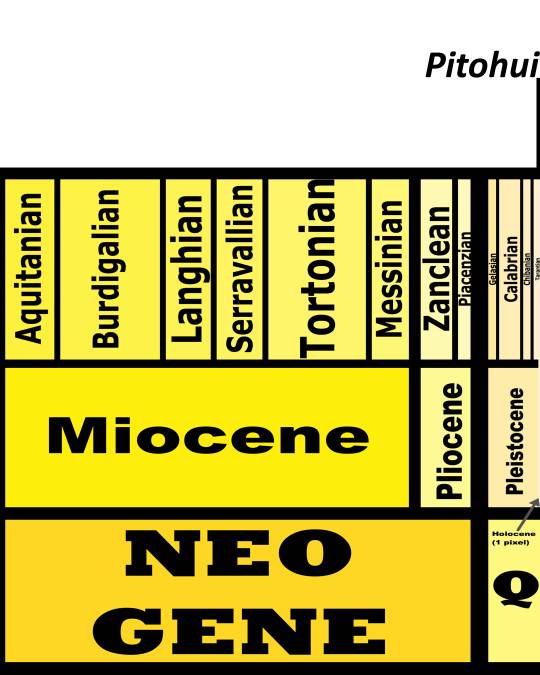
Pitohuis are endemic to New Guinea
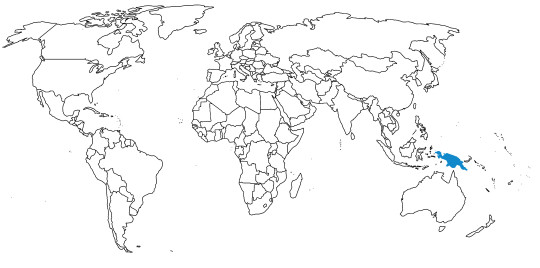
Physical Description: The Pitohuis look like your average Corvids - large passerines with dark coloration, thick bills, and high intelligence - but there’s more to these strange birds than meets the eye. Pitohuis are some of the rare examples of poisonous birds! Pitohuis tend to range in size between 20 and 26 centimeters long, and they are mostly black all over with brown to bright orange patches on their bellies or backs - though there is, of course, one species that is primarily brown. They have large, thick black bills, short wings, and short tails. The sexes tend to be very alike in these birds, though some species have subpopulations with different colorations. The juveniles, in general, are more brown in regions that are black in the adults. These birds are extremely toxic, with a neurotoxin called homobatrachotoxin in their skin, feathers, and other tissues. The least toxic parts of these birds are their bones. The toxins are secreted into their feathers on purpose; though some is left behind in muscle and organ tissue, which indicates a lack of sensitivity to the toxins by the birds. Some individuals do not have the toxins, probably due to a lack of the toxin-making beetles in their diets; but this is a variable occurrence and the vast majority of Pitohuis have the toxins in their feathers and skin.
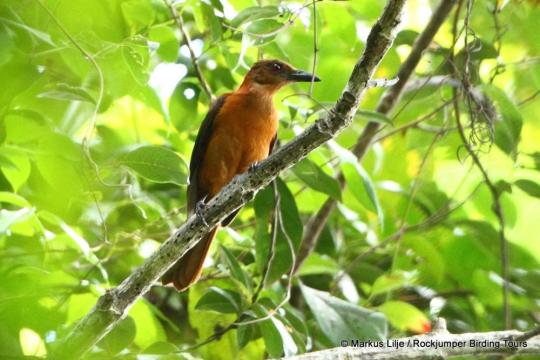
Southern Variable Pitohui by Markus Lilje
Diet: Pitohuis primarily feed on insects, though at least a few species also supplement their diets with fruit and seeds. Most importantly, they feed on beetles of the genus Choresine, which contain the toxin they incorporate into their feathers.

Raja Ampat Pitohui, by Carlos N. G. Bocos
Behavior: Pitohuis tend to forage at most levels of the forest, oftentimes in mixed-species flocks, though they are the ones that feed more on poisonous beetles than others in these flocks. They will hide in dense vegetation in order to avoid letting their prey know they’re there, but since they don’t have a lot of predators they don’t have to worry much about them. They do not migrate, but they are extremely vocal and social - making a variety of whistling and calls, which vary in word from species to species. Some are more leisurely than others, and they go between a variety of high and low pitches. Usually, they are quite musical and loud. Pitohuis begin breeding in early spring, and start nesting in the summer - though Hooded Pitohuis tend to lay more in the autumn. Multiple mated pairs probably work together to take care of the nest, which is a cup of vines and tendrils suspended on slender branches a few meters up from the ground. They typically lay one to two eggs a season.
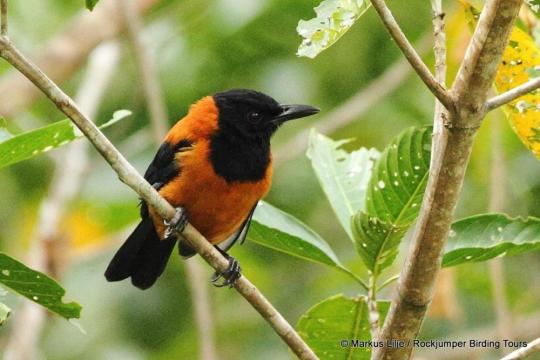
Hooded Pitohui by Markus Lilje
Ecosystem: Pitohuis live mainly in tropical rainforest and mangrove forests, as well as mountainous forests. They live at a variety of elevations, up to 2000 meters high; many species can also be found at forest edges and swamp forests, as well as lowlands. They do overlap with many other Pitohuis - including each other - and share the poisonous beetles among one another. Potential predators, including a variety of snakes, show marked sensitivity and irritation to even small amounts of the toxins found in the feathers of these birds - and as such, predators of the Pitohuis are not known at this time, at least of the adults. The young, who might not have as much of these toxins in their feathers and skin, are still vulnerable to nest raiders. Humans also do not feed on Pitohuis - leading to their name!
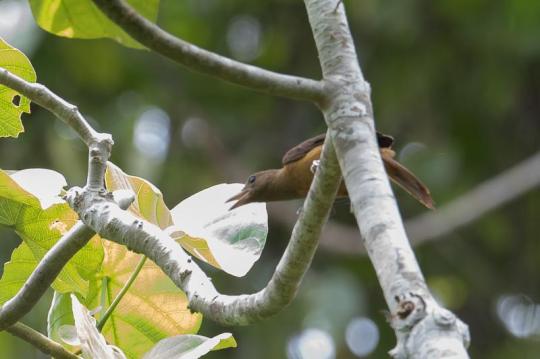
Northern Variable Pitohui by Paul van Giersbergen
Other: Toxicity in birds is an extremely rare trait, but it seems to have evolved multiple times in birds in New Guinea. In fact, Pitohui is a general name often used for any such poisonous bird, but recent scientific studies has showcased they’re not actually closely related at all! So, many species of Pitohui actually belong to other genera in not closely related groups of songbirds. While the ones we discussed today are Orioles, some are Bellbirds and others are Whistlers/Shrikethrushes. They are all, however, in the general Corvides group. The reasons as to why toxicity evolves in birds is debated - it may be a defensive measure (and is used as such), but it also might just be a consequence of their diet. They had to do something with the toxins from the beetles - so why not shed it out into their feathers? And then, BONUS! They aren’t eaten by a lot of predators! Regardless of how this odd trait began, they aren’t hunted or eaten very much as a result! Though having a limited range, the toxicity of these birds means that they are rarely fed upon by predators - including humans - and as such, they are common in their ranges.
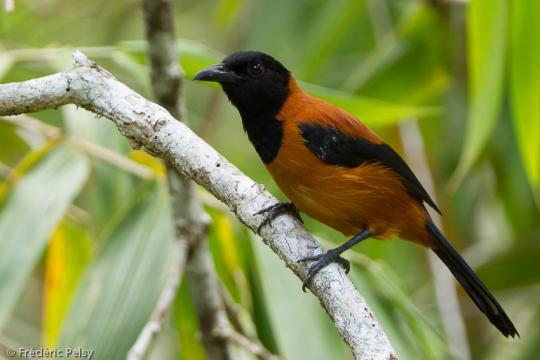
Hooded Pitohui by Frédéric Pelsy
Species Differences: The Pitohuis mainly differ based on their coloration from species to species, though there are some range differences (the Hooded and Northern Pitohuis live on the northern half of New Guinea, the Southern Pitohui on the Southern Half, and the Raja Ampat Pitohui only on the island of Waigeo. Hooded Pitohuis have black heads and wings, with black tails; the rest of their bodies are utterly black orange. Raja Ampat Pitohuis are brown almost everywhere, except for having a lighter orange on their bellies and black tips to their wings and tails. Northern Variable Pitohuis can be one of three color schemes: grey heads with brown backs black tails and wings and bright orange bellies; black heads with dark orange backs black wings black tails and lighter orange bellies; or dark orange on top all over and a lighter orange on the belly. Southern Variable Pitohuis can be black on their heads wings and tails with a dark red-orange on their backs and bellies; or black on their heads and tails and wings with dark orange on top and lighter orange on bottom in only the males, while the females have more brown heads. So much variation!
~ By Meig Dickson
Sources Under the Cut
Beadell, J.; Gering, E.; Austin, J.; Dumbacher, J.; Peirce, M.; Pratt, T.; Atkinson, C.; Fleischer, R. (2004). "Prevalence and differential host-specificity of two avian blood parasite genera in the Australo-Papuan region". Molecular Ecology. 13 (12): 3829–3844.
Boles, W. (2019). Hooded Pitohui (Pitohui dichrous). In: del Hoyo, J., Elliott, A., Sargatal, J., Christie, D.A. & de Juana, E. (eds.). Handbook of the Birds of the World Alive. Lynx Edicions, Barcelona.
Boles, W. & Kirwan, G.M. (2019). Northern Variable Pitohui (Pitohui kirhocephalus). In: del Hoyo, J., Elliott, A., Sargatal, J., Christie, D.A. & de Juana, E. (eds.). Handbook of the Birds of the World Alive. Lynx Edicions, Barcelona.
del Hoyo, J., Collar, N., Kirwan, G.M. & Boesman, P. (2019). Southern Variable Pitohui (Pitohui uropygialis). In: del Hoyo, J., Elliott, A., Sargatal, J., Christie, D.A. & de Juana, E. (eds.). Handbook of the Birds of the World Alive. Lynx Edicions, Barcelona.
del Hoyo, J., Collar, N., Kirwan, G.M. & Boesman, P. (2019). Waigeo Pitohui (Pitohui cerviniventris). In: del Hoyo, J., Elliott, A., Sargatal, J., Christie, D.A. & de Juana, E. (eds.). Handbook of the Birds of the World Alive. Lynx Edicions, Barcelona.
Diamond, J. (1987). "Flocks of brown and black New Guinean bird: a bicolored mixed-species foraging association". Emu. 87 (4): 201–211.
Dumbacher, J.; Beehler, B.; Spande, T.; Garraffo, H.; Daly, J. (1992). "Homobatrachotoxin in the genus Pitohui: chemical defense in birds?". Science. 258 (5083): 799–801.
Dumbacher, John P. (1999). "Evolution of toxicity in Pitohuis: I. Effects of homobatrachotoxin on chewing lice (Order Phthiraptera)". The Auk. 116 (4): 957–963.
Dumbacher, J. P.; Spande, T. F.; Daly, J. W. (2000). "Batrachotoxin alkaloids from passerine birds: A second toxic bird genus (Ifrita kowaldi) from New Guinea". Proceedings of the National Academy of Sciences. 97 (24): 12970–12975.
Dumbacher, J. P.; Fleischer, R. C. (2001). "Phylogenetic evidence for colour pattern convergence in toxic pitohuis: Mullerian mimicry in birds?". Proceedings of the Royal Society B: Biological Sciences. 268 (1480): 1971–1976.
Dumbacher, J. P.; Wako, A.; Derrickson, S. R.; Samuelson, A.; Spande, T. F.; Daly, J. W. (2004). "Melyrid beetles (Choresine): A putative source for the batrachotoxin alkaloids found in poison-dart frogs and toxic passerine birds". Proceedings of the National Academy of Sciences. 101 (45): 15857–15860.
Dumbacher, J; Deiner, K; Thompson, L; Fleischer, R (2008). "Phylogeny of the avian genus Pitohui and the evolution of toxicity in birds". Molecular Phylogenetics and Evolution. 49 (3): 774–781.
Dumbacher, John P.; Menon, Gopinathan K.; Daly, John W. (2009). "Skin as a toxin storage organ in the endemic New Guinean genus Pitohui". The Auk. 126 (3): 520–530.
Glendinning, J. (1993). "Pitohui: how toxic and to whom?". Science. 259 (5095): 582–583.
Jønsson, K. A; Bowie, R. C.K; Norman, J. A; Christidis, L.; Fjeldsa, J. (2008). "Polyphyletic origin of toxic Pitohui birds suggests widespread occurrence of toxicity in corvoid birds". Biology Letters. 4 (1): 71–74.
Jønsson, Knud A.; Bowie, Rauri C. K.; Moyle, Robert G.; Irestedt, Martin; Christidis, Les; Norman, Janette A.; Fjeldså, Jon (2010). "Phylogeny and biogeography of Oriolidae (Aves: Passeriformes)". Ecography. 33 (2): 232–241.
Lamothe, L. (1979). "Diet of some birds in Araucaria and Pinus forests in Papua New Guinea". Emu. 79 (1): 36–37.
Legge, S.; Heinsohn, R. (1996). "Cooperative breeding in Hooded Pitohuis (Pitohui dichrous)". Emu. 96 (2): 139–140.
Ligabue-Braun, Rodrigo; Carlini, Célia Regina (2015). "Poisonous birds: A timely review". Toxicon. 99: 102–108.
Menon, Gopinathan K.; Dumbacher, John P. (2014). "A "toxin mantle" as defensive barrier in a tropical bird: evolutionary exploitation of the basic permeability barrier forming organelles". Experimental Dermatology. 23 (4): 288–290.
Mouritsen, Kim N.; Madsen, Jørn (1994). "Toxic birds: defence against parasites?". Oikos. 69 (2): 357.
Poulsen, B. O. (1994). "Poison in birds: against predators or ectoparasites?". Emu. 94 (2): 128–129.
Sam, Katerina; Koane, Bonny; Jeppy, Samuel; Sykorova, Jana; Novotny, Vojtech (2017). "Diet of land birds along an elevational gradient in Papua New Guinea". Scientific Reports. 7 (44018): 44018.
#Pitohui#bird#Dinosaur#Songbird#Poisonous Bird#Passeriform#Perching Bird#Songbird Saturday & Sunday#Quaternary#Australia & Oceania#Insectivore#Northern Variable Pitohui#Raja Ampat Pitohui#Southern Variable Pitohui#Hooded Pitohui#Pitohui kirhocephalus#Pitohui cerviniventris#Pitohui uropygialis#Pitohuis dichrous#Birds#Dinosaurs#Factfile#Birblr#Waigeo Pitohui#biology#a dinosaur a day#a-dinosaur-a-day#dinosaur of the day#dinosaur-of-the-day#science
161 notes
·
View notes
Text
Animal of the Day!
Hooded Pitohui (Pitohui dichrous)

(Photo by Frederic Pelsy)
Conservation Status- Least Concern
Habitat- New Guinea
Size (Weight/Length)- 70 g; 23 cm
Diet- Fruit; Seeds; Insects
Cool Facts- At first glance, the hooded pitohui looks like a brightly colored songbird. However, those bright colors aren’t for attracting a mate. Instead, the hooded pitohui secrets a neurotoxin from its skin, similar to that of poison dart frogs. These toxins result in a slow and painful death for any creature brave enough to even touch one of these birds. Living in small flocks, hooded pitohui stay in the canopy of thick rainforests. When nesting, the entire flock helps to raise chicks from several different nests.
Rating- 13/10 (Surprisingly, a poisonous bird isn’t the weirdest animal on the planet.)
#Animal of the day#Animals#Birds#Tuesday#July 5#Hooded pitohui#biology#science#conservation#the more you know
81 notes
·
View notes
Note
Hello friend! I love your blog!
Can you tell me about poisonous birds? I trust you way more than Google, especially with its new unreliable AI...
POISONOUS BIRBS:
Hey there, so I know about Pitohuis (there are 8 species), Blue-capped Ifrit, Regent Whistler, Rufous-naped Bellbird, Arafura Shrikethrush, Rufous Shrikethrush sequester Batrachotoxins in their feathers and skin (as well as in some internal organs), obtained from their diet (most likely beetles in the genus Choresine). All are endemic to New Guinea.
Red Warblers, Spur-winged Geese, European Common Quail, Bronzewing Pigeons, and Ruffed Grouse also sequester toxins form various insects, seeds, and berries (depending on the species), and can be toxic.
Hoopoes have bacteria in their uropygial glands that produce toxins.

Hooded Pitohui (Pitohui dichrous), family Oriolidae, order Passeriformes, endemic to New Guinea
photograph by Knud Jønsson

Blue-capped Ifrit (Ifrita kowaldi), family Ifritidae, order Passeriformes, endemic to New Guinea
photograph by Frédéric PELSY

Rufous Shrikethrush (Colluricincla rufogaster), family Pachycephalidae, order Passeriformes, emdemic to New Guinea
photograph by JJ Harrison

Regent Whistler (Pachycephala schlegelii), family Pachycephalidae, order Passeriformes, endemic to New Guinea
photograph by Bradley Hacker

Rufous-naped Bellbird (Aleadryas rufinucha), family Oreocidae, order Passeriformes, endemic to New Guinea
photograph by Jerry_Oldenettel
#bird#poisonous#toxic birds#animals#nature#pitohui#bellbird#aleadryas#oreacidae#oriolidae#hoopoe#pachycephala#pachycephalidae#whistler#shrikethrush#ifrit#ifritidae#toxin#poison#batrachotoxin#new guinea
196 notes
·
View notes
Text
BOTD: Hooded Pitohui

^ photo credit: Wikipedia
Hooded Pitohui (pitohui dichrous)
The Hooded Pitohui is one of the few actually poisonous (not venomous) birds. They contain very potent toxins in their skin and feathers, which are thought to be derived from their diet. It's thought that these toxins both deter predators and protect the bird from parasites.
#bird of the day#botd#tropical birds#birds#hooded pitohui#pitohui#poisonous bird#bird#bird facts#bird fact#animal facts#birdwatching#birding#birb
69 notes
·
View notes
Text

[Image ID: to be done]
Pitodichronic.
plain text: Pitodichronic.
— A gender related to / connected to Hooded Pitohuis in some way.
— Pito (from 'pitohui') + dichron (from 'dichrous') + ic
— Coined by us. Requested by no one.
#mogai term#mogai coining#mogai community#mogai blog#mogai safe#mogai identity#mogai label#mogai gender#mogai flag#mogai#liom term#liom coining#liom community#liom blog#liom safe#liom identity#liom label#liom gender#liom flag#term coining#gender coining#lgbtq#oaks coining cabinet
12 notes
·
View notes
Text
BRACKET D
Magnificent Frigatebird (Fregata magnificens)
They look a bit strange with their big red chests. They make other birds vomit by pecking them just so that they can eat whatever comes back up.
VERSUS
Hooded Pitohui (Pitohui dichrous)
These things are poisonous! Their entire bodies are loaded with toxins that they spread on themselves! Very cool!

17 notes
·
View notes
